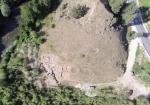Summary (English)
ARCHAEOLOGICAL EXPLORATIONS NEAR THE VILLAGE OF BANYA (Bogdan Athanassov – bo.atana@nbu.bg, Iliya Kulov) A few Chalcolithic sherds were found on the site so far. During the transition period between the Late Bronze and the Early Iron Age, the elevation was occupied and protected with the monumental fortification Wall No. 2, 1.60 – 1.80 m wide. In 2014, the upper layers of the debris of the Early Construction Phase were explored in Trenches I58, K58, I59, K59 and K60. The First Construction Stage of that phase ended with a fire. The Second Construction Stage began with leveling the terrain. Fortification Wall No. 2 was built during that stage. Part of a building was explored in trenches K59 and L59 and part of a burned wall was discovered, constructed of wattle-and-daub and wooden beams supporting the structure. The results of the radiocarbon analysis of carbonized grain originating from the context of the Early Construction Phase supported its dating to the 12th century BC. The finds included Thracian sherds dated to the transition period between the Late Bronze and the Early Iron Age, originating from cups, kantharoi, pots, amphora-like vessels, bowls, dishes, jugs, strainers and dolia. The osteological analysis of the animal bones showed that during the Early Construction Phase the boars and the pigs prevailed, followed by sheep and goats and by ox. The results from the analysis of the isotopes of carbon, azoth and strontium contained in the animal teeth showed that the sheep and the goats were probably taken out to graze in areas that were different from the areas where the ox was taken out to graze.
- Bogdan Athanassov - Department of Archaeology, New Bulgarian University
- Iliya Kulov - Regional Museum of History – Blagoevgrad
Director
Team
Research Body
- New Bulgarian University
- Regional Museum of History – Blagoevgrad






![Download [PDF]](/excavation/skins/fasti/images/results/download_sml.png)

